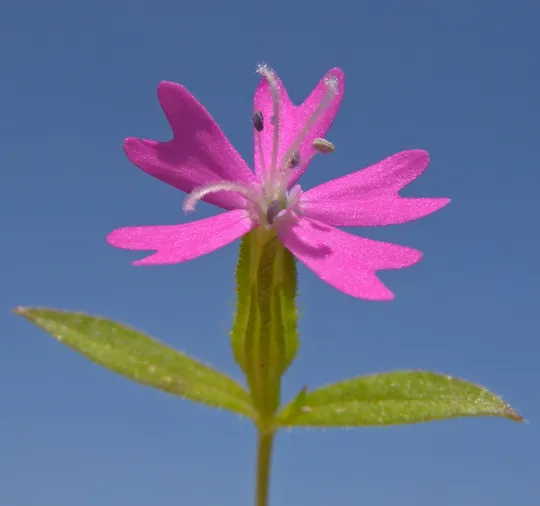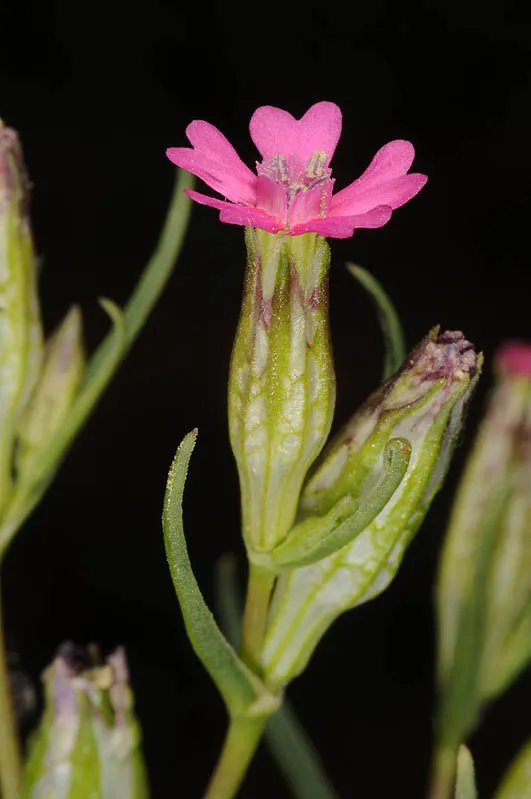Warty Catchfly
Silene papillosa


Silene papillosa grows on the
coastal plain in only two regions: the Sharon and Pleshet. At present, its
presence is certain at only three sites, although there are probably four sites
in Israel. The primary S. papillosa site in the Sharon is in the hamra (red
loam) badlands east of Ramat HaKovesh, where it was observed several times in 1983-2006.
An additional site is the Netanya Forest (Sergeants Grove), where Noa Moshe,
Itai Nahshon and Amit Mendelsohn saw a single plant in 2006. It is extinct from
an additional site in Sharon, Herzliya, where Eig, Zohary and Feinbron collected
it in 1928. Ruhama Berliner and Avi Schmida were the first to collect S.
papillosa in the Philistine Plain in Ruhama in 1970 and Oz
Golan found it there again in 2009 . It also grows in the Gaza Strip near the
HaBsor Stream (Abou Auda et al., 2009).
In Israel – on hamra (red loam) badlands, hamra fields,
sandy hamra and calcareous sandstone on the coastal plain. According to Post's
Flora, in the countries in its range S. papillosa
grows in mountainous areas in addition to coastal sands, but this is not the
case in Israel. In Turkey, it is found in open forests of Quercus
suber (a vicarious species of Q. calliprinos) (Deniz
& Dusen, 2004).
For the genus – see Silene sedoides.
S. papillosa
belongs to the section Lasiocalycinae in the genus Silene that is
characterized by annual species with dichotomous branching that have a fertile
calyx dissected at the top before its opening and mainly by its calyx veins
that have ciliate hairs with a nipple-like base. Only three species are known
in Israel: S. papillosa, S. crassipes and S. telavivensis.
S. sumbuliana is a very close species that was first discovered as a new
species to science at a single site west of Antalya in Turkey. It grows at an
altitude of 1800-1850 m in a Cedrus libani forest. Despite its proximity and similarity to S.
papillosa, S. sumbuliana differs from it
by a number of morphological indicators, including its petals that are almost
not dissected into two lobes and by its much later flowering time (Deniz and Dusen, 2004).
·
Silene papillosa now grows in the
same two regions as it did in the past, on a very small number of sites.
However, it has disappeared from one of the sites (Herzliya).
·
There are only a few individuals at
each site, never more than a few dozen plants.
·
The populations are threatened by
their small size, which may interfere with fertilization and seed production
and lead to local extinction due to random environmental fluctuations. The main
site at Ramat HaKovesh is located at the
heart of cultivated areas and may be affected by activities carried out there.
·
The S. papillosa sites in the Sharon
are not protected in nature reserves. The Ruhama Badlands Reserve is at the
proposal stage.
·
Information regarding the threat
status of S. papillosa in other countries in its range is
lacking.
The small,
uncultivated area east of Ramat
HaKovesh should be demarcated and cultivation should be prevented. The population at
the site should be subject to long-term monitoring on an annual basis. The
Netanya Forest population should be reinforced by seeding from local sources
(if possible) or seeds brought in from Ramat HaKovesh. Efforts should be made to ensure the
function of the forest as a recreation and picnic site will not interfere with
the plant's continued existence. S. papillosa should be grown in refuge gardens for
use in restoration in case of extinction.
Silene papillosa has a
relatively narrow range and is endemic to Mediterranean Turkey, Syria, Lebanon
and Israel; there is also data regarding its presence in the Aegean Islands and
Cyprus.
Silene papillosa is an annual plant
that grows on hamra (red loam) and calcareous sandstone on the coastal plain. It is endemic
to the countries of the Levant and extremely rare in Israel, where its
populations are small. S. papillosa is endangered because of its rarity,
the size of its populations and the vulnerability of its habitat.
Deniz,I.G., and Dusen, O.D. 2004. Silene sumbuliana (Caryophyllaceae) – a new species from SW Anatolia, Turkey. Ann bot. Fennici 41: 293-296.
Abou Auda M. M., Deeb N. Y. and EL Sahhar 2009. K. F. The Flora and Plant Life Forms Of Wadi Gaza Area, Middle Governorate, Palestine. 4th Conference on Recent Technologies in Agriculture, 201-213.
Current Occupancy Map
| 1000 squre meter pixel | 5000 squre meter pixel | 10000 squre meter pixel | |
|---|---|---|---|
| number of observations | 0 | 0 | 0 |
| in total pixels | 0 | 0 | 0 |
| Family | Caryophyllaceae |
| Classification | On the endangered species list |
| Ecosystem | Coastal area |
| Chorotype | Eastern Mediterranean |
| Conservation Site | Hamra Badlands east of Ramat HaKovesh |
| Rarity |
1
6
6
|
|---|---|
| Vulnerability |
0
4
4
|
| Attractiveness |
0
1
4
|
| Endemism |
0
1
4
|
| Red number |
1
6.8
10
|
| Peripherality | N |
| IUCN category | DD EW EX LC CR EN VU NT |
| Threat Definition according to the red book | Critically endangered |
 Based on:
Based on:






